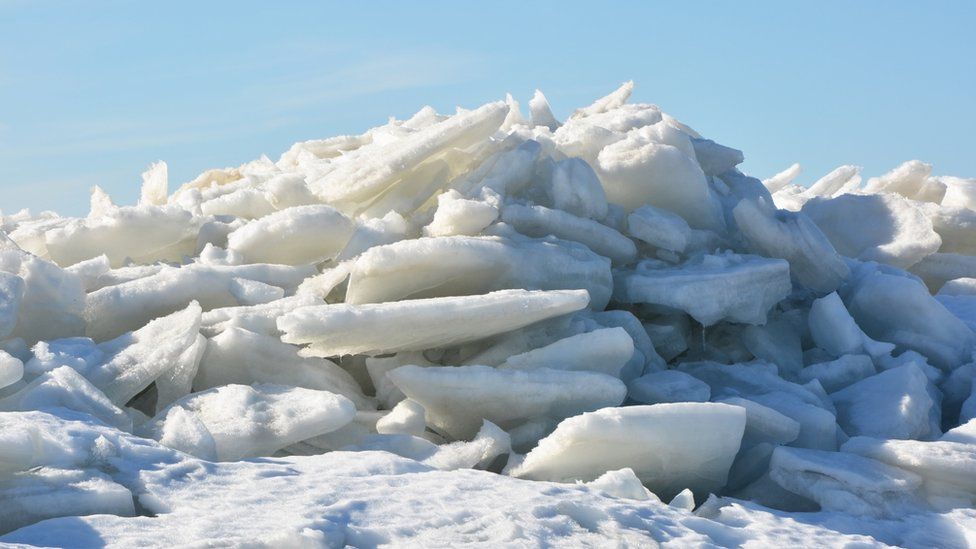Arctic sea-ice struggles to build volume
- Published

There is likely to be about 10,500 cu km of Arctic sea-ice by the end of the week - a volume that would tie for the lowest on record for a November.
It is another indicator of just how warm conditions in the polar north have been of late.
Temperatures of -5C have been logged when -25C would be the norm.
Ice extent - the two-dimensional measure of frozen ocean surface - is also well down, running currently at just over 9.4 million sq km.
Ordinarily, it would be at least a million sq km higher.
The latest volume assessment comes from the Earth-orbiting Cryosat mission.
This European Space Agency satellite carries a radar altimeter designed specifically for the purpose of studying marine floes.
At present, it is the only way to monitor sea-ice volume across the entire Arctic basin.
What is interesting in its new data is that average sea-ice thickness stands today at roughly 130cm.
This represents the 5th thickest November in the Cryosat record, meaning the low volume is pretty much all down to the low extent.
This is most evident at southerly latitudes in the Beaufort, East Siberian and Kara seas, where the warm October/November conditions have been very keenly felt.
"When the Autumn freeze-up occurs, it is the low latitudes that would normally see the fastest growth in ice, in areas of open water or over thin floes. But because of the warm autumn, these regions simply haven't been able to build this volume," said Dr Rachel Tilling from the Nerc Centre for Polar Observation and Modelling at Leeds University, UK.
Cryosat's volume determination on Monday was for 10,200 cu km.
Scientists expect perhaps 300 cu km to be added to floes in the last days of the month.
The resulting 10,500 cu km would then match what was seen in November 2011 and 2012, taking account of the errors that exist in such measurements.
"There is no doubt that sea-ice growth this Autumn has been sluggish and with Cryosat we've witnessed the smallest November growth on record," explained Dr Tilling.
"Usually, it grows by about 160 cu km per day, but this November it's been 139 cu km per day - just under 10% lower."
Volume is really the key metric when considering the status of Arctic sea-ice.
Only thinking about extent, or area, can hide the fact that winds will sometimes spread out the floes and sometimes pile them up.
Talking in terms of volume captures more of the overall behaviour in the Arctic system.
Cryosat gauges volume by first measuring the difference in height between the top of the floating part of the sea-ice and the sea surface.
Knowing the size of this "freeboard" enables scientists to estimate the overall thickness of the ice. Multiplying by the area then gives gives the volume.
"Being able to measure sea-ice thickness means that we can be sure how much is actually there, because changes in melting, snowfall, and drift all affect how thick the ice pack is and this is hidden in maps of extent alone," emphasised Leeds' Prof Andrew Shepherd, the principal scientific adviser to the Cryosat mission.
"It's also of interest for ships attempting to navigate the Arctic's ice-infested waters. Because Cryosat is the only sensor able to do this, it's an essential tool for climate scientists and maritime operators alike."
Follow-on mission
Launched in 2010, Cryosat is now operating beyond its design lifetime.
How long the spacecraft can continue working is anyone's guess.
It has enough fuel to sustain itself into the early 2020s but component failure in the harsh environment of its orbit, 720km above the Earth, is an ever-present risk.
Europe's research ministers meeting in Lucerne, Switzerland, on Thursday have been asked to consider funding R&D for a replacement satellite.
This Cryosat follow-on spacecraft - if eventually approved for full development - would likely carry an even more sophisticated radar altimeter than the present mission.
It would be multi-frequency in operation and able better to discern the depth of snow sitting on top of the ice. This is one of the factors that adds uncertainty to the calculation of sea-ice thickness and ultimately volume.
- Cryosat's radar has the resolution to see the Arctic's floes and leads
- Some 7/8 of the ice tends to sit below the waterline - the draft
- The aim is to measure the freeboard - the ice part above the waterline
- Knowing this 1/8th figure allows Cryosat to work out sea-ice thickness
- The thickness multiplied by the area of ice cover produces a volume
- Volume - not area - is the best guide to the status of Arctic sea ice
- Cryosat's measurement technique works in autumn, winter and spring
- Melt ponds on the ice make a mid-summer assessment very difficult
Jonathan.Amos-INTERNET@bbc.co.uk and follow me on Twitter: @BBCAmos
- Published12 May 2016
- Published24 March 2016